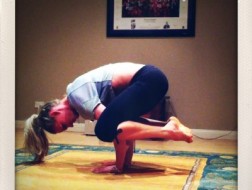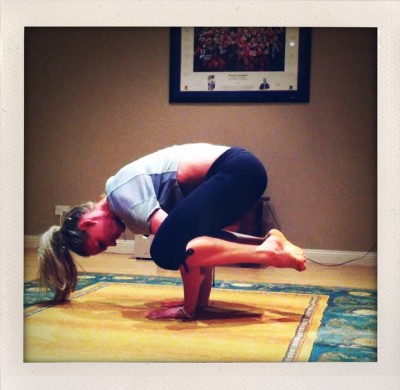My thoughts on…Bikram Yoga

I’m not sure when it was that I first heard about bikram yoga, but I just assumed that it was one of those passing exercise fads. Only…I kept hearing about it. So then I decided to try it. I’m the type of person who always wants to try things out for myself and then form my own opinions about them, without caring too much about what the media says, what is “in fashion” in the exercise world, or even what the current studies say.
Just a quick explanation on what Bikram yoga is: It’s a series of yoga postures performed in a heated room (about 40 degrees with 40% humidity). The classes are 90 minutes long. This style of yoga was developed in the 1970s by yoga master Bikram Choudhury,who holds a patent on his sequence of 26 postures and two breathing exercises, all guided by a specific dialogue. Classes accredited by Choudhury are called Bikram yoga, and are all formatted the same. Classes named “hot yoga” or “hot room yoga” will be similar to bikram yoga, but vary somewhat in format and style.
Promoters of the practice claim that hot yoga will purify the body of toxins, improve flexibility and range of motion (this is definitely true), enhance the immune system, and promote weight loss. Some even claim that the practice has cured them of diseases such as multiple sclerosis and hepatitis. There is no research to support many of these claims, but even though hot yoga may not be a cure-all for everything under the sun (can’t you tell I’m a skeptic), I’ve personally found that the extreme heat certainly facilitates the loosening of tight muscles, allowing deeper stretching. It has also DEFINITELY helped me with my weight training, especially mobility-wise. I find that I’m a lot better at the olympic lifts, especially locking out with the weight overhead, as well as squatting and handstands etc. I also like what yoga has done for my posture and body alignment; just body awareness in general. Now when I train, I feel every muscle that's in action; I know what is going on in every part of my body, what is being activated and used and what I need to switch on more. It's pretty awesome.
Also because of the extreme heat your lungs get a pretty intense workout. They have to work harder to get air in, so I have personally found it's benefited my breathing and oxygen intake, especially when it comes to high intensity training. Lungs having to work harder = increased stamina. I really like this about it.
Although, while I find yoga very beneficial for me personally as a supplement to my normal training, doing Bikram yoga or hot yoga alone will not not give you enough results if you are looking to make aerobic improvements. Actually I had this question myself, and I recently read in the November issue of Bret Contreras' Strength and Conditioning research that Bikram yoga just doesn't cut it if you are looking for satisfactory aerobic improvements. Although it's interesting to note from their research, that regular bikram yoga practice (regardless of experience) may lower resting heart rate and blood pressure, which is a pretty cool perk if you ask me.
Compared to other yoga (and I’ve tried a lot of different types) Bikram Yoga has a reputation for being a pretty strict class. If you’ve tried it, you know the game: keep quiet before and after the class; don’t drink water until after the first three postures; make sure you stay in the room the whole 90 minutes, etc. There are valid reasons for instructors to strongly encourage these things but it’s too much for some yogis. Because of this, I wouldn’t say bikram yoga is for everybody. This also makes it a somewhat controversial type of yoga practice.
It’s also a pretty long class. Ninety minutes is asking a lot from people, in a world that relies on 140 characters tweets, face time phone calls, and instant status updates. The commitment can be too much for some people to handle. Some people might find it just a bit too long for their liking.
I like that the class is not as “spiritual” and focused on mind-body connection as a lot of other types of yoga. While I do like a little meditation and believe in the power of the mind, I am not one for extreme displays of introspection or over-spiritualistic rituals. I personally find it a little pretentious and a bit of a waste of time. From practicing bikram regularly I’ve definitely begun to have a deeper connection with my body, mind and soul, and I’ve found I’m better able to cope with difficult and stressful situations. I do appreciate that aspect of it, although I’ll never be an ultra spiritual, meditating yogi. For those who are like me and not the most spiritual type, they might appreciate birkam as they don’t overdo it on that side of things.
I would recommend Bikram or hot yoga to people who have a good base in fitness already, as an extra to add in, especially for mobility work and flexibility. I do it once a week as a supplementary training/recovery routine. If you find you are getting very tight in your muscles from a lot of weight training, or if you are prone to injuries and strains from exercise, bikram yoga could be extremely beneficial for you. Here are some of my hot tips (pun alert!!) for making your bikram yoga experience as pleasant as possible:
- Maintain a daily intake of at least eight (and preferably 10) cups of water the day for normal activity, not including exercise.
- Drink a few big glasses of water at least 2 hours before your practice! (this is so important!)
- Weigh yourself prior to class, if possible.
- During class, drink frequently and before you feel too thirsty. (But they like you to wait until the first three postures are completed.
- If you start to feel light-headed, nauseated, or otherwise sick, stop and lie down. They don’t recommend leaving the room. I am not too sure why they don’t, but I think it has something to do with adjusting to the temperature, especially for your first few classes. If you stay in the room and just lie on your back you should start to feel better.
- Weigh yourself again after exercise. Notice if you have lost any (fluid) weight, and consume enough water to return to your pre-exercise weight.
- Necessary items include a water bottle and towel (a large one to cover your entire mat). If you can bring a thermos water bottle and fill it with cold water and then wrap towels around it the water will stay cold. Otherwise you may find yourslef drinking hot water by the end of the class. I also find that I like to bring a smaller towel to wipe sweat off my face.
- Bring your own mat, unless you want to to share old sweat,because hot yoga is a messy business.
- Clothing should be comfortable and breathable (Minimal if possible) and obviously not susceptible to sweat stains.
- Speaking of sweat, it would also be wise to bring a change of clothes as you sweat so much you could wring sweat out of your clothes.
- Eat a banana after your practice. They contain potassium which is an important mineral your body needs to restock up after losing a lot of fluids through sweating.
The very first time I did bikram yoga about two years ago, I felt very tired after my practice. I went to bed early that night. Ever since then every time I have done it I’ve felt energized and rejuvenated for the rest of the day. In my opinion you should aim to practice it at least once a week to reap the benefits from it.
It’s worth a try. You might love it, or hate it. If nothing else, at least you can tick it off your bucket list of things to try before you die.
As for me, I’ll keep doing it once a week as I am a firm believer in the benefits of it.
The 26-posture series, as practiced by little faceless people. Photo courtesy of: Indianabikram.com
Here are a couple of other yoga articles I've read and loved which I wanted to link here as well.
9 reasons why yoga is good for gym junkies by Neghar Fonooni
Beyond the mat: 5 new reasons to take yoga (stretching & relaxing not included) by Jen Comas Keck
Join the other 10,000+ who get my best fitness, diet & mindset tips.




Comments